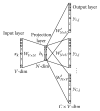Automated Text Analysis Based on Skip-Gram Model for Food Evaluation in Predicting Consumer Acceptance
- PMID: 29606960
- PMCID: PMC5828055
- DOI: 10.1155/2018/9293437
Automated Text Analysis Based on Skip-Gram Model for Food Evaluation in Predicting Consumer Acceptance
Abstract
The purpose of this paper is to evaluate food taste, smell, and characteristics from consumers' online reviews. Several studies in food sensory evaluation have been presented for consumer acceptance. However, these studies need taste descriptive word lexicon, and they are not suitable for analyzing large number of evaluators to predict consumer acceptance. In this paper, an automated text analysis method for food evaluation is presented to analyze and compare recently introduced two jjampong ramen types (mixed seafood noodles). To avoid building a sensory word lexicon, consumers' reviews are collected from SNS. Then, by training word embedding model with acquired reviews, words in the large amount of review text are converted into vectors. Based on these words represented as vectors, inference is performed to evaluate taste and smell of two jjampong ramen types. Finally, the reliability and merits of the proposed food evaluation method are confirmed by a comparison with the results from an actual consumer preference taste evaluation.
Figures











Similar articles
-
Identifying drivers for consumer acceptance and purchase intent of corn tortilla.J Food Sci. 2007 Nov;72(9):S727-31. doi: 10.1111/j.1750-3841.2007.00564.x. J Food Sci. 2007. PMID: 18034760
-
Predicting consumer liking and preference based on emotional responses and sensory perception: A study with basic taste solutions.Food Res Int. 2017 Oct;100(Pt 1):325-334. doi: 10.1016/j.foodres.2017.07.021. Epub 2017 Jul 9. Food Res Int. 2017. PMID: 28873694
-
Sensory nutrition: The role of taste in the reviews of commercial food products.Physiol Behav. 2019 Oct 1;209:112579. doi: 10.1016/j.physbeh.2019.112579. Epub 2019 Jun 12. Physiol Behav. 2019. PMID: 31199938 Review.
-
Sensory characteristics and cross-cultural consumer acceptability of Bulgogi (Korean traditional barbecued beef).J Food Sci. 2011 Jun-Jul;76(5):S306-13. doi: 10.1111/j.1750-3841.2011.02173.x. Epub 2011 Apr 27. J Food Sci. 2011. PMID: 22417445
-
The Voice of Chinese Health Consumers: A Text Mining Approach to Web-Based Physician Reviews.J Med Internet Res. 2016 May 10;18(5):e108. doi: 10.2196/jmir.4430. J Med Internet Res. 2016. PMID: 27165558 Free PMC article. Review.
Cited by
-
Appeal of word of mouth: Influences of public opinions and sentiment on ports in corporate choice of import and export trade in the post-COVID-19 era.Ocean Coast Manag. 2022 Jun 15;225:106239. doi: 10.1016/j.ocecoaman.2022.106239. Epub 2022 Jun 1. Ocean Coast Manag. 2022. PMID: 36467315 Free PMC article.
-
Green-Labelled Rice versus Conventional Rice: Perception and Emotion of Chinese Consumers Based on Review Mining.Foods. 2022 Dec 24;12(1):87. doi: 10.3390/foods12010087. Foods. 2022. PMID: 36613303 Free PMC article.
References
-
- Lee J., Jeong S., Rho J. O., Park K. A study on the korean taste adjectives and emotional evaluation scale. Journal of Next-generation Convergence Information Services Technology. 2013;2(2):59–66.
-
- Lee J., Ghimire D., Rho J. O. Rough clustering of Korean foods based on adjectives for taste evaluation. Proceedings of the 2013 10th International Conference on Fuzzy Systems and Knowledge Discovery (FSKD); July 2013; Shenyang, China. IEEE; pp. 472–475.
-
- Lee J., Park K., Rho J. O. Fuzzy relation-based analysis of Korean foods and adjectives for taste evaluation. Journal of Korean Institute of Intelligent Systems. 2013;23(5):451–459.
-
- Turian J., Ratinov L., Bengio Y. Word representations: a simple and general method for semi-supervised learning. Proceedings of the 48th annual meeting of the association for computational linguistics. :384–394. Association for Computational Linguistics.
-
- Mikolov T., Chen K., Corrado G., Dean J. Efficient estimation of word representations in vector space. Computer Science. 2013 https://arxiv.org/abs/1301.3781.
MeSH terms
LinkOut - more resources
Full Text Sources
Other Literature Sources

